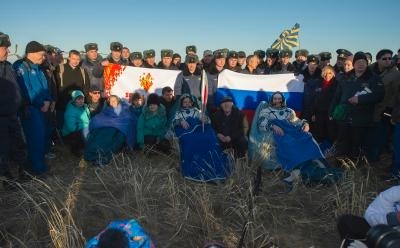Tue, Nov 12, 2013
Expedition 37 Crew Lands In Kazakhstan After 166 Days in Space
Expedition 37 crew members Karen Nyberg of NASA, Fyodor Yurchikhin of the Russian Federal Space Agency and Luca Parmitano of the European Space Agency have returned to Earth from the International Space Station, landing at 2149 EST Sunday, Nov. 10 (8:49 a.m. Kazakhstan time, Nov. 11), after spending 166 days in space.

Inside the Soyuz spacecraft carrying the astronauts was the Olympic torch, which was launched to the station Nov. 6 and taken on a spacewalk Saturday as part of the torch relay. The torch will be used to light the Olympic flame at the Fisht Stadium in Sochi, Russia, marking the start of the 2014 Winter Games in February.
Nyberg, Parmitano and Yurchikhin arrived at the station in May, and during their extended stay in space orbited Earth 2,656 times and traveled more than 70 million miles. Parmitano conducted a spacewalk in July, becoming the first Italian to walk in space. The crew welcomed Orbital Sciences Corp.'s Cygnus cargo spacecraft during its demonstration mission to the station. The trio spent hundreds of hours conducting fundamental research in areas such as human biology, life sciences, physical sciences, Earth sciences, astrophysics and technology research.
Yurchikhin now has logged 537 days in space, spanning four spaceflights. This puts him 12th on the all-time endurance list. Nyberg has accumulated 180 days in space over two missions. This was Parmitano's first mission.
The crew performed research into how plants grow, which may lead to more efficient crops on Earth and improve understanding of how future crews could grow their own food in space. They tested a new portable gas monitor designed to help analyze the environment inside the space station and continued fuel and combustion experiments undertaken by past crews. The crew also collected data and samples that will be used to help scientists understand ocular health issues of space station crew members and understand changes to body measurements during spaceflight.
More News
From 2023 (YouTube Version): Legacy of a Titan Robert (Bob) Anderson Hoover was a fighter pilot, test pilot, flight instructor, and air show superstar. More so, Bob Hoover was an i>[...]
Get The Latest in Aviation News NOW on Instagram Are you on Instagram yet? It's been around for a few years, quietly picking up traction mostly thanks to everybody's new obsession >[...]
Aero Linx: B-52H Stratofortress The B-52H Stratofortress is a long-range, heavy bomber that can perform a variety of missions. The bomber is capable of flying at high subsonic spee>[...]
Altimeter Setting The barometric pressure reading used to adjust a pressure altimeter for variations in existing atmospheric pressure or to the standard altimeter setting (29.92).>[...]
"Knowing that we play an active part in bettering people's lives is extremely rewarding. My team and I are very thankful for the opportunity to be here and to help in any way we ca>[...]
 Classic Aero-TV: Remembering Bob Hoover
Classic Aero-TV: Remembering Bob Hoover ANN FAQ: Follow Us On Instagram!
ANN FAQ: Follow Us On Instagram! ANN's Daily Aero-Linx (05.15.24)
ANN's Daily Aero-Linx (05.15.24) ANN's Daily Aero-Term (05.15.24):Altimeter Setting
ANN's Daily Aero-Term (05.15.24):Altimeter Setting Aero-News: Quote of the Day (05.16.24)
Aero-News: Quote of the Day (05.16.24)



